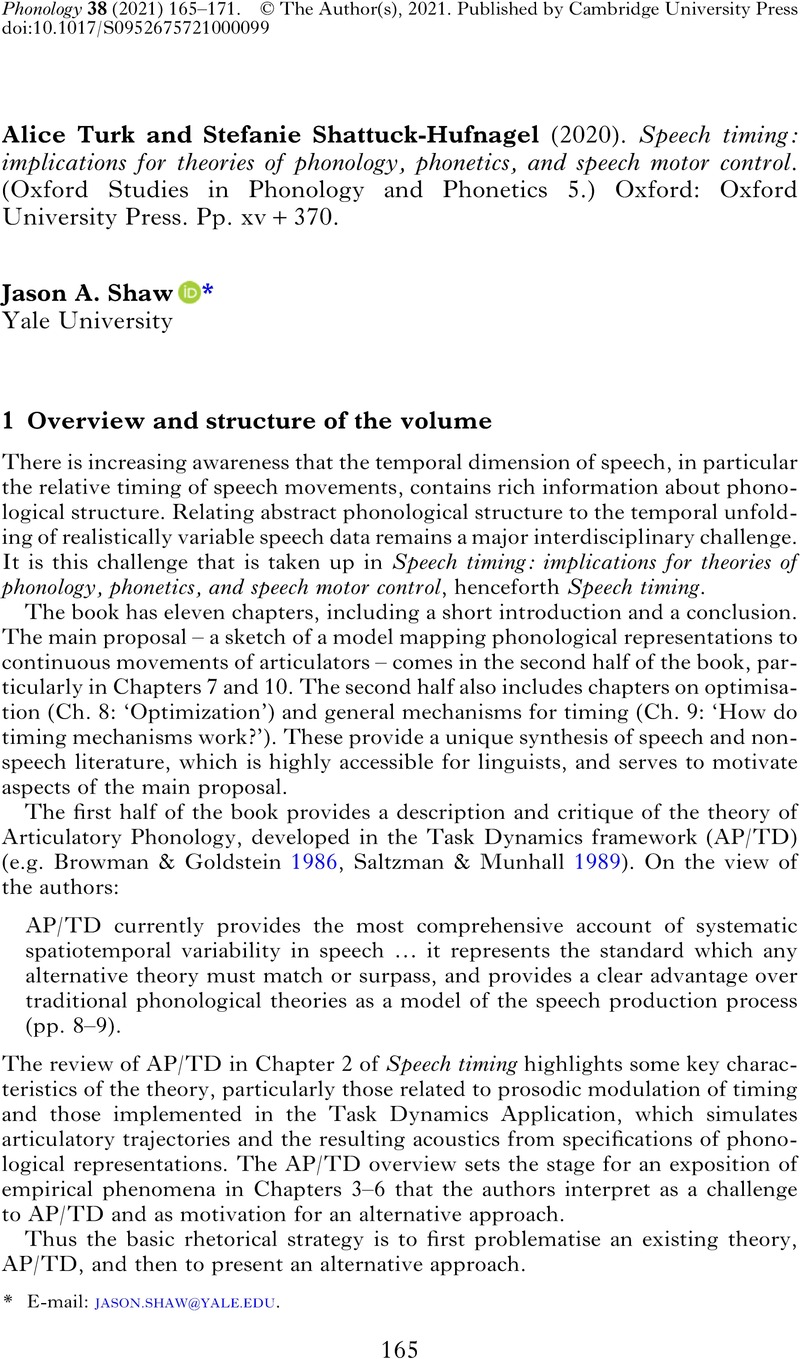No CrossRef data available.
Article contents
Alice Turk and Stefanie Shattuck-Hufnagel (2020). Speech timing: implications for theories of phonology, phonetics, and speech motor control. (Oxford Studies in Phonology and Phonetics 5.) Oxford: Oxford University Press. Pp. xv + 370.
Review products
Alice Turk and Stefanie Shattuck-Hufnagel (2020). Speech timing: implications for theories of phonology, phonetics, and speech motor control. (Oxford Studies in Phonology and Phonetics 5.) Oxford: Oxford University Press. Pp. xv + 370.
Published online by Cambridge University Press: 02 July 2021
Abstract
An abstract is not available for this content so a preview has been provided. Please use the Get access link above for information on how to access this content.

- Type
- Review
- Information
- Copyright
- Copyright © The Author(s), 2021. Published by Cambridge University Press
References
Boersma, Paul (1998). Functional phonology: formalizing the interactions between articulatory and perceptual drives. PhD dissertation, University of Amsterdam.Google Scholar
Bombien, Lasse, Mooshammer, Christine & Hoole, Philip (2013). Articulatory coordination in word-initial clusters of German. JPh 41. 546–561.Google Scholar
Browman, Catherine P. & Goldstein, Louis (1986). Towards an articulatory phonology. Phonology Yearbook 3. 219–252.Google Scholar
Browman, Catherine P. & Goldstein, Louis (1988). Some notes on syllable structure in articulatory phonology. Phonetica 45. 140–155.Google ScholarPubMed
Browman, Catherine P. & Goldstein, Louis (1989). Articulatory gestures as phonological units. Phonology 6. 201–251.CrossRefGoogle Scholar
Byrd, Dani & Saltzman, Elliot (2003). The elastic phrase: modeling the dynamics of boundary-adjacent lengthening. JPh 31. 149–180.Google Scholar
Faytak, Matthew D. (2018). Articulatory uniformity through articulatory reuse: insights from an ultrasound study of Sūzhōu Chinese. PhD dissertation, University of California, Berkeley.CrossRefGoogle Scholar
Flemming, Edward (2001). Scalar and categorical phenomena in a unified model of phonetics and phonology. Phonology 18. 7–44.CrossRefGoogle Scholar
Gao, Man (2008). Mandarin tones: an Articulatory Phonology account. PhD dissertation, Yale University.Google Scholar
Hermes, Anne, Mücke, Doris & Auris, Bastian (2017). The variability of syllable patterns in Tashlhiyt Berber and Polish. JPh 64. 127–144.Google Scholar
Hermes, Anne, Mücke, Doris & Grice, Martine (2013). Gestural coordination of Italian word-initial clusters: the case of ‘impure s’. Phonology 30. 1–25.CrossRefGoogle Scholar
Katsika, Argyro, Krivokapić, Jelena, Mooshammer, Christine, Tiede, Mark & Goldstein, Louis (2014). The coordination of boundary tones and its interaction with prominence. JPh 44. 62–82.Google ScholarPubMed
Lee, David N. (1998). Guiding movement by coupling taus. Ecological Psychology 10. 221–250.CrossRefGoogle Scholar
Lee, David N. & Turk, Alice (in preparation). Vocalizing by tauG-guiding articulators.Google Scholar
Nakai, Satsuki, Kunnari, Sari, Turk, Alice, Suomi, Kari & Ylitalo, Riikka (2009). Utterance-final lengthening and quantity in Northern Finnish. JPh 37. 29–45.Google Scholar
Nakai, Satsuki, Turk, Alice, Suomi, Kari, Granlund, Sonia, Ylitalo, Riikka & Kunnari, Sari (2012). Quantity constraints on the temporal implementation of phrasal prosody in Northern Finnish. JPh 40. 796–807.Google Scholar
Parrell, Benjamin & Lammert, Adam C. (2019). Bridging dynamical systems and optimal trajectory approaches to speech motor control with dynamic movement primitives. Frontiers in Psychology 10:2251. https://doi.org/10.3389/fpsyg.2019.02251.CrossRefGoogle ScholarPubMed
Perkell, Joseph S. & Matties, Melanie L. (1992). Temporal measures of anticipatory labial coarticulation for the vowel /u/: within- and cross-subject variability. JASA 91. 2911–2925.CrossRefGoogle ScholarPubMed
Saltzman, Elliot & Munhall, Kevin G. (1989). A dynamical approach to gestural patterning in speech production. Ecological Psychology 1. 333–382.CrossRefGoogle Scholar
Shaw, Jason A. & Chen, Wei-rong (2019). Spatially conditioned speech timing: evidence and implications. Frontiers in Psychology 10:2726. https://doi.org/10.3389/fpsyg.2019.02726.CrossRefGoogle ScholarPubMed
Shaw, Jason A. & Davidson, Lisa (2011). Perceptual similarity in input–output mappings: a computational/experimental study of non-native speech production. Lingua 121. 1344–1358.CrossRefGoogle Scholar
Shaw, Jason A., Gafos, Adamantios I., Hoole, Philip & Zeroual, Chakir (2011). Dynamic invariance in the phonetic expression of syllable structure: a case study of Moroccan Arabic consonant clusters. Phonology 28. 455–490.CrossRefGoogle Scholar





